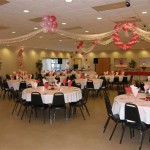How To Decorate Mandir At Home On Diwali
Diwali, the festival of lights, is a time for celebration, reflection, and spiritual rejuvenation. A central part of Diwali celebrations in many Hindu households is the decoration of the Mandir, or home temple. The Mandir is considered a sacred space, a focal point for prayer and devotion, and adorning it beautifully for Diwali is an act of reverence and an invitation for divine blessings. Effective Mandir decoration goes beyond aesthetics; it involves creating an atmosphere of serenity, purity, and devotion. Here's a comprehensive guide on how to decorate a Mandir at home for Diwali.
Before commencing the decoration process, it is crucial to thoroughly clean the Mandir. This involves removing any accumulated dust, cobwebs, and clutter. Use a gentle cleaning solution to wipe down the surfaces of the idols, shelves, and the surrounding area. This initial step is not merely about hygiene; it symbolizes the purification of the mind and spirit, preparing the space to receive positive energy and blessings.
Once the cleaning is complete, consider the overall theme and color palette for the decoration. Traditional Diwali colors include vibrant shades of red, orange, yellow, and gold. These colors represent auspiciousness, prosperity, and energy. However, one can also incorporate other colors that resonate personally, ensuring that the overall ambiance is harmonious and visually appealing. The chosen color scheme should reflect the celebratory spirit of Diwali while maintaining the sanctity of the Mandir.
The selection of decorative elements should be done thoughtfully. Opt for items that are both aesthetically pleasing and religiously significant. Avoid using anything that might be considered disrespectful or inappropriate for a sacred space. Remember that the purpose of the decoration is to enhance the spiritual atmosphere of the Mandir, not merely to create a visually impressive display.
Selecting and Arranging Idols
The arrangement of idols within the Mandir is of paramount importance. Ensure that all idols are properly cleaned and adorned with new clothes or accessories. Consider their significance and the traditional order in which they are typically placed. Often, a central deity is placed in a prominent position, with other deities arranged around them respectfully. The arrangement should be aesthetically pleasing, creating a sense of balance and harmony within the Mandir.
Specific deities are often associated with Diwali. Lakshmi, the goddess of wealth and prosperity, and Ganesha, the remover of obstacles, are particularly important. Ensure that their idols are given a place of honor within the Mandir. Other deities commonly worshipped during Diwali include Saraswati, the goddess of knowledge and wisdom, and Kubera, the treasurer of the gods. The inclusion of these deities reinforces the blessings sought during Diwali: prosperity, wisdom, and success.
The attire of the idols plays a significant role in the overall presentation. New clothes are traditionally offered to the deities during Diwali. These clothes can be made of silk, cotton, or other fine fabrics. The colors and designs should be chosen carefully to complement the overall theme of the Mandir decoration. In addition to clothing, consider adorning the idols with jewelry, such as necklaces, earrings, and bracelets. These accessories enhance the regal appearance of the deities and add a touch of grandeur to the Mandir.
Incorporating Lights and Diyas
Lights, especially diyas (oil lamps), are an integral part of Diwali celebrations. The very essence of Diwali is the triumph of light over darkness, and the illumination of the Mandir with diyas symbolizes the dispelling of ignorance and the welcoming of knowledge and enlightenment. Arrange diyas around the idols, along the shelves, and at the entrance of the Mandir. Ensure that the diyas are placed securely and away from flammable materials.
In addition to diyas, consider using other types of lights to enhance the ambiance of the Mandir. String lights, such as fairy lights or LED lights, can be used to create a warm and inviting glow. Place these lights along the walls, around the idols, or draped over the shelves. Choose lights with a soft, warm tone to create a serene and peaceful atmosphere. Avoid using harsh or overly bright lights, as they can detract from the spiritual ambiance of the Mandir.
Candles can also be used to add a touch of elegance and sophistication to the Mandir decoration. Use candles of various sizes and shapes to create a visually appealing display. Scented candles can also be used to infuse the Mandir with a pleasant fragrance. Choose scents that are traditionally associated with Diwali, such as sandalwood, jasmine, or rose. However, be mindful of allergies and avoid using scents that might be overpowering or irritating.
Using Flowers and Foliage
Flowers and foliage are essential elements in Mandir decoration. Flowers symbolize purity, beauty, and devotion, and they are used to adorn the idols, the shelves, and the surrounding area. Fresh flowers are preferred, but artificial flowers can also be used as a supplement. Choose flowers that are traditionally associated with Hindu deities, such as lotus, marigold, jasmine, and rose.
Garlands of flowers are commonly used to adorn the idols. These garlands can be made of a single type of flower or a combination of different flowers. The garlands should be fresh and fragrant, and they should be carefully placed around the necks of the idols. In addition to garlands, individual flowers can be placed at the feet of the idols as an offering of devotion.
Foliage, such as leaves and branches, can be used to create a backdrop for the idols or to add a touch of greenery to the Mandir. Mango leaves are considered particularly auspicious and are often used to decorate doorways and Mandirs during festivals. Other types of foliage that can be used include ferns, ivy, and eucalyptus leaves. The foliage should be fresh and well-maintained, and it should be arranged in a way that complements the overall decoration.
Rangoli, a traditional Indian art form, is another popular way to decorate the Mandir during Diwali. Rangoli involves creating intricate designs on the floor using colored powders, rice flour, or flower petals. The designs can be simple or elaborate, and they often depict auspicious symbols, such as swastikas, lotuses, and diyas. Rangoli adds a touch of color and artistry to the Mandir, and it is believed to bring good luck and prosperity.
Other decorative elements that can be used include bells, incense, and religious symbols. Bells are used to create a sacred atmosphere and to invoke the presence of the deities. Incense is used to purify the air and to create a fragrant ambiance. Religious symbols, such as Om or the Swastika, can be placed on the walls or shelves to reinforce the spiritual significance of the Mandir. The selection of these elements should be done thoughtfully, ensuring that they are appropriate for a sacred space.
Maintaining the cleanliness and order of the Mandir throughout the Diwali celebrations is essential. Regularly clean the area, replace wilted flowers, and replenish the diyas with oil. This ongoing maintenance ensures that the Mandir remains a sacred and inviting space for prayer and devotion. It also demonstrates respect for the deities and a commitment to maintaining the sanctity of the home temple.
The decoration of the Mandir for Diwali is a deeply personal and meaningful endeavor. It is an opportunity to express devotion, to connect with the divine, and to create a sacred space within the home. By following these guidelines and incorporating personal touches, one can create a Mandir that is both visually stunning and spiritually uplifting, enhancing the overall Diwali celebrations and inviting blessings into the household.

35 Diwali Mandir Decoration Ideas With Diyas Flowers More

Diwali Pooja Room Decoration Tips Beautiful Homes

Small Home Temple Festival Decor Ideas Er Friendly Mandir Diwali Decoration

35 Diwali Mandir Decoration Ideas With Diyas Flowers More

Pin By Diya Mahi On Puja Decoration Diwali Decorations At Home Items

Diwali Home Decoration Ideas With Items List 2025 Jaipurcrafts

Mandir Decoration For Diwali 2025 Ideas

Diwali Decoration Final Touches For A Ready Home

35 Diwali Mandir Decoration Ideas With Diyas Flowers More

Diwali Decorations At Home Lights Ideas
Related Posts







